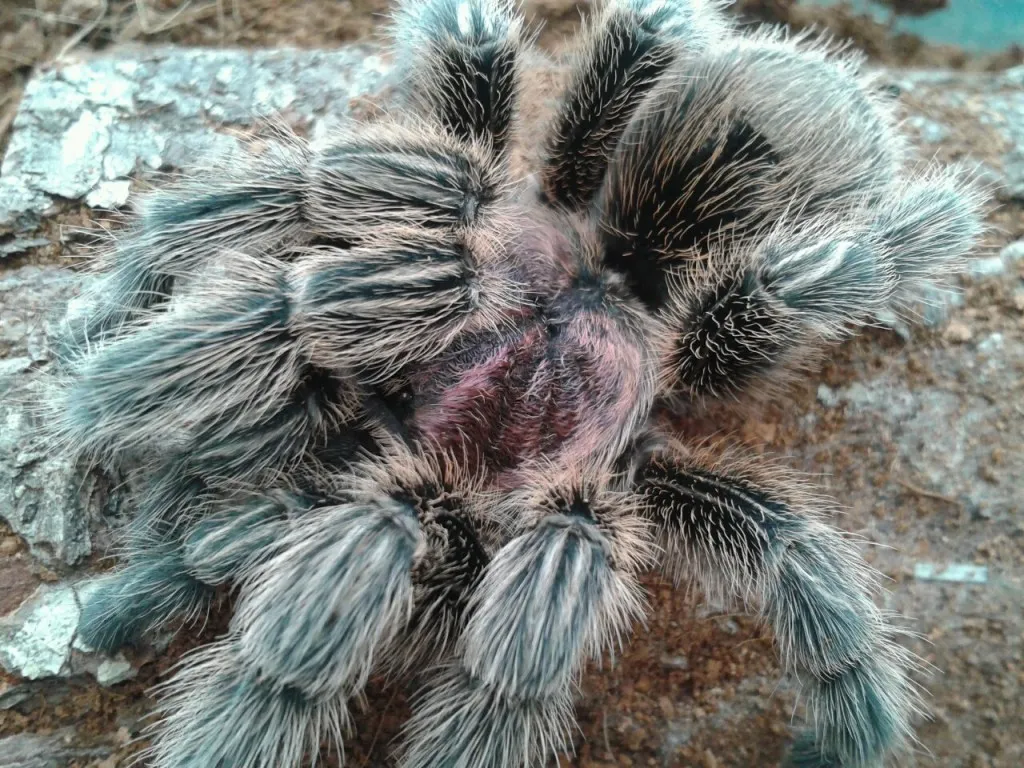Understanding Tarantula Behavior
Before determining if tarantula keeping is cruel, it’s crucial to understand their natural behaviors. Tarantulas are primarily solitary creatures, spending most of their lives in burrows or sheltered areas. They are ambush predators, relying on stealth and speed to catch prey. Their activity levels vary depending on species, environmental conditions, and feeding schedules. This understanding is the foundation for evaluating whether their needs can be adequately met in captivity. Consider the instincts that drive them, like burrowing, hunting, and the avoidance of perceived threats. A captive environment that fails to account for these basic instincts may inadvertently cause stress and suffering. Observing a tarantula’s natural behaviors provides a baseline for understanding their welfare needs. Understanding these creatures is a core aspect of deciding whether their captivity is ethical.
Natural Habitat and Lifestyle
Tarantulas inhabit diverse environments, from tropical rainforests to deserts. Their lifestyle is largely dictated by their habitat. Some species construct elaborate burrows, while others utilize natural shelters like rock crevices or beneath logs. The humidity, temperature, and substrate composition of their natural environment are critical to their survival. They are adapted to specific climatic conditions, and any deviation from these conditions can impact their health and well-being. Examining their wild existence provides a benchmark for creating a suitable captive environment. The goal is to replicate, as closely as possible, the essential elements of their natural world within the confines of a terrarium or enclosure. Doing so improves their quality of life while in your care.
Tarantula Needs in Captivity

The well-being of a captive tarantula hinges on the ability of the keeper to replicate its natural environmental and meet its basic needs. This involves providing a suitable habitat, proper nutrition, and a degree of enrichment to prevent boredom and stress. Failing to meet these needs can lead to a range of health issues and behavioral problems, raising questions about the ethics of tarantula keeping. Understanding their needs in captivity is the fundamental starting point in determining whether their well-being can be met in a captive environment. It is the responsibility of the keeper to provide an environment in which the tarantula can thrive and express its natural behaviors, or decide whether they should consider getting a tarantula.
Environmental Needs
Environmental needs include maintaining appropriate temperature, humidity, and substrate conditions. Tarantulas are ectothermic, meaning they rely on external sources of heat to regulate their body temperature. Providing a thermal gradient within the enclosure allows the tarantula to move to areas where it can maintain its preferred temperature. Humidity is essential for proper molting and hydration, and it must be appropriate for the specific species. The substrate should allow for burrowing (if the species burrows) and must retain moisture. The enclosure itself must be appropriately sized and secure to prevent escape. These environmental elements are vital to a tarantula’s health and comfort, mimicking the conditions that they are accustomed to.
Nutritional Needs
Tarantulas are carnivorous, and their diet primarily consists of insects. The frequency of feeding and the size of the prey should be adjusted based on the tarantula’s size and growth stage. Providing a variety of insects can ensure a balanced diet, which is essential for optimal health and molting. Ensuring a readily available water source is crucial for hydration. Overfeeding can lead to health problems, and underfeeding can result in starvation. Proper nutrition is critical for the tarantula’s development, vitality, and overall welfare. A balanced diet is essential for all aspects of their life.
Social Needs and Enrichment

As solitary creatures, tarantulas don’t require social interaction. However, enrichment is still vital to prevent boredom and stimulate natural behaviors. This can include providing varied substrates, hiding places, and opportunities for burrowing. While they do not necessarily need other tarantulas, they need to be challenged by their environment. Enrichment helps to prevent the development of stress-related behaviors. The environment provided must encourage their natural instinct to thrive and hunt, providing opportunities for them to exercise.
Signs of Stress and Poor Welfare
Recognizing signs of stress is essential for responsible tarantula keeping. These signs include loss of appetite, erratic movements, and defensive posturing. Behavioral changes, such as excessive hiding, are also warning signs. Physical indicators such as a dry or wrinkled abdomen, can also indicate distress. If these signs are present, it suggests that the tarantula’s needs are not being met, which may indicate an environment that is stressful and therefore cruel. Being aware of these indicators is crucial for ensuring that the animal’s welfare is prioritized. This observation allows the keeper to immediately address any issues and make necessary adjustments to the environment, which is the responsibility of the owner.
Assessing the Ethics of Tarantula Keeping
Ethical considerations surrounding tarantula keeping involve weighing the potential benefits and harms to the animal. The central question is whether captivity is a justifiable practice, given the tarantula’s needs and the potential for suffering. This assessment requires critical thinking and a thorough understanding of tarantula behavior, welfare, and the realities of captive environments. The keeper must be able to assess whether it is ethical, not only to own a tarantula, but to provide them with all the elements necessary to ensure a thriving life while in their care. Being able to answer this question is the most fundamental aspect to assess the ethics involved.
Arguments Against Keeping Tarantulas

Some argue that keeping tarantulas is inherently cruel because captivity restricts their natural behaviors and can lead to stress and suffering. They suggest that even the most well-intentioned keepers may not be able to fully replicate the conditions of a tarantula’s natural habitat. Others point out the potential for tarantulas to be acquired impulsively or without adequate knowledge, resulting in neglect. Concerns are also raised about the potential for tarantulas to be sourced from the wild, which can harm wild populations. This is a critical aspect of assessing ethical ownership. These arguments highlight the importance of responsible ownership, including the understanding of the tarantula’s welfare.
Arguments for Keeping Tarantulas
Proponents of tarantula keeping argue that, when done responsibly, it can provide a rewarding experience for both the keeper and the tarantula. They emphasize the educational value of observing these fascinating creatures and the opportunity to learn about their biology and behavior. They also note that captive-bred tarantulas help to reduce the demand for wild-caught specimens. Well-informed keepers can provide suitable habitats and proper care, ensuring the animal’s physical and psychological well-being. It provides a unique opportunity to appreciate the natural world and educate others about arachnids. Responsible practices are key to ensuring that their welfare is met.
Responsible Tarantula Ownership
Responsible tarantula ownership involves prioritizing the animal’s welfare. This includes acquiring the necessary knowledge, providing a suitable habitat, meeting nutritional needs, and enriching the environment. It also involves being prepared to provide lifelong care and understanding the animal’s specific needs. Careful consideration must be given to the ethical implications of keeping a tarantula. The goal is to create an environment where the tarantula can thrive and express its natural behaviors. Being responsible is a core function of the keeper, in all that they do. This is the most important aspect to a tarantula thriving in captivity.
Providing Optimal Habitat

A suitable habitat is the foundation of responsible tarantula keeping. This involves selecting an appropriately sized enclosure, providing a suitable substrate, and maintaining optimal temperature and humidity levels. The enclosure should be escape-proof and offer opportunities for the tarantula to engage in natural behaviors. Providing hiding places and a water dish are also essential. The habitat must replicate the animal’s natural environment. It must provide comfort, and allow for burrowing or climbing, depending on the tarantula’s needs. Setting up a habitat is the starting point for a tarantula’s wellbeing and the keepers’ ethical responsibility.
Meeting Nutritional Needs
Providing a balanced diet is crucial for a tarantula’s health. This typically involves feeding insects that are appropriate for the tarantula’s size and species. The insects should be gut-loaded before feeding to provide essential nutrients. Clean, fresh water must always be available. It is important to avoid overfeeding, as this can lead to health problems. Feeding frequency should be adjusted based on the tarantula’s age, species, and activity level. A proper diet is required for healthy growth, molting, and overall well-being of your tarantula.
Enrichment and Stimulation
Even though tarantulas don’t require social interaction, enrichment is important to prevent boredom and encourage natural behaviors. This can include providing varied substrates, offering different types of hiding places, and occasionally rearranging the enclosure. Enrichment helps stimulate the tarantula mentally. A well-enriched environment can improve the tarantula’s overall welfare. The keeper should provide items for the tarantula to climb, burrow, or explore, as appropriate for its species. Enrichment improves the animal’s quality of life and helps prevent the development of stress-related behaviors.
Conclusion Is Tarantula Keeping Cruel?

The question of whether tarantula keeping is cruel doesn’t have a simple answer. It depends on the actions of the keeper. While the basic needs of tarantulas are relatively simple, failing to meet these needs can cause considerable suffering. However, with the proper knowledge, dedication, and resources, it is possible to create an environment where a tarantula can thrive. Responsible tarantula keeping is about prioritizing the animal’s welfare by ensuring proper care, enrichment, and a suitable habitat. Ultimately, the ethical implications of keeping a tarantula depend on the keeper’s commitment to providing the best possible life for the animal. The answer is on you, as the keeper, to determine if you will provide a thriving life for your tarantula.
